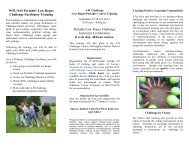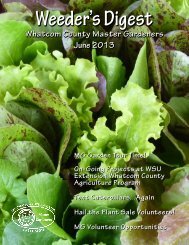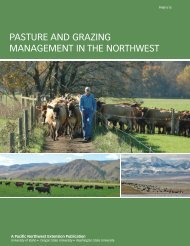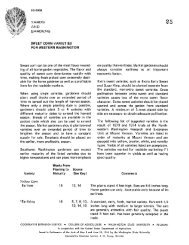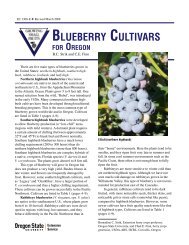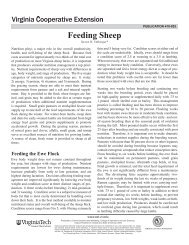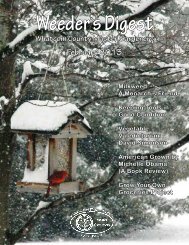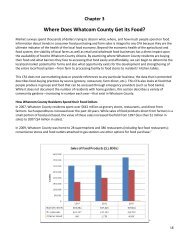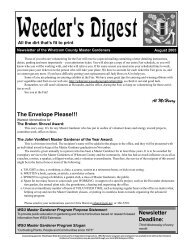Weeder’s DigestPlant of the Month............................ By Cheryll Greenwood KinsleyCannaFamily: Cannaceae(Canna family)Genus: CannaLily-of-the-valley—Convallaria majalis—is the “official” plant for the month of <strong>May</strong>. But thisyear, let’s think larger and bolder. Much larger and much bolder.Recently I’ve been bitten by the summer-bulb bug, for reasons that aren’t entirely clear, even tome. Perhaps it’s because I want to explore yet another new aspect of gardening. But it’s also apractical way to deal with some bare spots in the garden—particularly in places where Ihaven’t yet hit on the specific plant I want to install as a permanent resident. Bulbs are easyand quick to put in and practically grow themselves—and here, I’m using the catchall term“bulb” to include rhizomes, corms, tubers, and tuberous roots. So for summer color I canchoose from begonias, lilies, and gladiolus—and dahlias, of course. I leave the growing of thelatter to Dick Porter. For years I’ve also eschewed lilies and glads. And cannas I wouldn’teven consider. But this year, inexplicably, I’m fascinated with them all—especially canna lilies.<strong>May</strong>be it’s all the times I’ve admired them in Peace Arch Park while waiting in line to cross theborder. Or it might be distant memories of old gardens I knew as a child. Didn’t all our grandmothersgrow “common” red cannas?At last count, the genus Canna—the only one in the Cannaceae family—included 55species indigenous to the tropics and now naturalized around the world. Canna edulis isnative to South America, where its fleshy rhizomes are a food source. They’re dried andpulverized into what’s called tous les mois in France and “arrowroot flour” in Britain—although the arrowroot we use here in cooking as a thickener comes from Marantaarundinacea, another plant entirely. The seeds of several canna species are used to makejewelry, because they’re very hard and uniformly shaped. It’s rumored they served as asubstitute for lead shot in flintlock muskets during the 18 th and 19 th centuries.The canna lily is a perennial grown from a rhizome, just like the lily-of-the valley. Thetwo plants are otherwise unrelated, although the large leaves of the canna do resemble thetiny leaves of the lily-of-the-valley, in form if not in color or size. Linnaeus categorized Canna indica—and he didn’t use leaves so much as the reproductive parts of flowers to organize his classifications.The Canna flower has one stamen and one pistil, which placed it in the Monandria class and theMonogynia order. The word “canna” is from the Latin for “cane” or “reed,” and Linnaeus named thatfirst species he saw after what he thought was its country of origin—India.What our grandmothers grew might have been Canna indica. It’s actually a New World nativeand grows in the wild throughout the Caribbean and Pacific islands, where it’s on the verge of beingdeclared a nuisance. It’s unlikely to take hold to that degree in our area. An enormous number of namedvarieties are now available for our home gardens, and show-stopping they can be. Choose yourscarefully. There are cannas with small flowers and others with very large flowers, in a range of brilliantcolors. The foliage varies from variety to variety and is frequently as extraordinary as the flowers. Youmay actually have to depend on the foliage for effect rather than on the flowers, because cannas bloomlate in what they hope will be a hot summer. They may be slow to blossom here, in any given year, andmay not come into their own until the weather is too cool to sustain them. Where they do get a greatdeal of heat, some varieties can top out at almost fifteen feet, but you’re unlikely to see that here in ourcool-summer climate. Those that are full-size may make it to five feet. If even that’s too much height forthe space you have available, select one of the many dwarf varieties. You’ll get the same great flowersand almost as many outstanding foliage choices, but on plants that are only two or three feet high.Plant your canna rhizomes before the middle of <strong>May</strong> in the richest, most moisture-retentive soilyou can manage, where they’ll get full sun. Place them about four inches deep and eighteen inchesapart—eyes up if you can find them, but don’t worry if you can’t. Just lay the rhizomes in the groundhorizontally. Cannas are heavy feeders, so add some fertilizer according to package directions when youplant and at monthly intervals during the summer. Use a complete, balanced formulation or—better—one that goes easy on the nitrogen. Avoid feeding cannas excess amounts of this particular nutrient, somake sure that first number is not greater than the other two. All cannas need at least some moistureadministered regularly. Read up on your varieties to learn their specific requirements. Some are actuallybog plants and will thrive along the shallow edges of ponds. Others are marginal, and appreciate wetfeet. Many will do fine with a weekly deep soak.Watch for slugs when the shoots emerge, and keep checking through the growing season. Weknow our abundant slug population has quite a taste for things succulent and tropical! Then standback. When late summer rolls around, you’ll appreciate the “bold” move you took in <strong>May</strong>.
<strong>May</strong> 2004Garden Friends and Foes ..................................... By Todd MurrayThe European PaperwaspOrder: HymenopteraFamily: VespidaeSpecies: PolistesdominulusFigure 1. Unknown yellowjacket (left)and P. dominulus (right). Note thedifference in body shape, wastes, andlegs.Figure 2. Newly emerged queenconstructing a new nest under eaves.Description and Life HistoryRemember getting harassed by yellowjackets last August when you began to prepare yourgardens for winter? You thought that you’d get a break before they harassed you again, didn’t you? Inrecent years, it appears that yellowjackets didn’t reach their annual harassment quotas; they seem to bewaiting to bother you in early spring, as early as March.<strong>Whatcom</strong> <strong>County</strong>, along with the rest of the country, has inherited anothercritter from Europe. This new troublesome wasp is actually NOT a yellowjacket, but apaperwasp. The European paperwasp, Polistes dominulus, was first recorded in theU.S. in Massachusetts, 1981. We have specimens in our Master Gardener insectcollection dated the year 2000. <strong>Washington</strong> <strong>State</strong>’s first record for the Europeanpaperwasp was in 1998. Over a period of twenty years, this wasp appeared to spreadfrom coast to coast.P. dominulus has markings similar to the typical yellowjacket and are oftenconfused with yellowjackets; they have the black and yellow warning colorationstriped along their bodies. One superficial way to tell the difference is noting the bodyshape. Paperwasps in general are more slender and have longer legs. The constrictionat the abdomen to the thorax is more gradual for paperwasps, while the constriction ofthe waist on yellowjackets tends to be abrupt.Nesting habits are the easiest way to tell the difference between Polistes waspsand yellowjackets. Paperwasps create nests that are only one cell deep forming a singlecomb and resembling an upside down umbrella. The comb is not in an envelope and isexposed to the outside world. Yellowjackets create large aerial nests that are entirelyenclosed in paper. Yellowjackets will also construct nests below the soil surface.Female P. dominulus wasps overwinter as fertile adults in protected habitats suchas under tree bark, woodpiles and inside walls of structures. Females become active inearly spring, beginning in late March or early April. Overwintering females can colonizean existing nest from the previous year, or construct a new nest made from chewed andpulped wood fiber. The queen initially spends her time laying eggs and rearing theyoung. Queens deposit eggs singly into individual cells. These cells are home for thewasp larvae until they reach adulthood. The queen brings back prey items, such ascaterpillars, and macerates the prey to feed to the developing larvae. The first broodcan hatch to adults within forty days, given good environmental conditions. After thefirst brood, the queen continues to reproduce while the newly emerged workers take onthe duties of foraging and maintaining the nest. Dr. Peter Landolt, USDA entomologistin Yakima, says that nests can grow large enough for 400 cells; however, most nestscontain less than 100 cells. Male wasps, produced late in the season, mate with nextseason’s new queens. The fertilized females seek out overwintering shelters to beginthe lifecycle for next year.Damage: Garden friend or foe?Generally, Polistes dominulus has brought excellent early-season biologicalcontrol of many pests in <strong>Whatcom</strong> <strong>County</strong>. Not many natural enemies of insect pestsare out in early spring. I have witnessed European paperwasps feeding on winter mothlarvae this season. P. dominulus solely feeds on insect prey items.Paperwasps can inflict painful stings when disturbed just as yellowjackets.Paperwasps are capable of stinging multiple times. So far, the European paperwasp hadFigure 3. Egg deposited inside cellbeen described as docile in the Pacific Northwest. While photographing a queen, Ibumped her with the camera lens and she just shot me a dirty look and went back towork. Eric LaGasa (our state entomologists) claims that P. dominulus will give you a“courtesy bump” telling you to back off before they threaten to sting you. Back east, this species islabeled as a fierce defender of nests and will attack potential threats. From what I’ve witnessed, thewasps are docile and are only concerned about maintaining their nests. Rarely do I see aggression whenI’m present around their nests.Continued on next page



